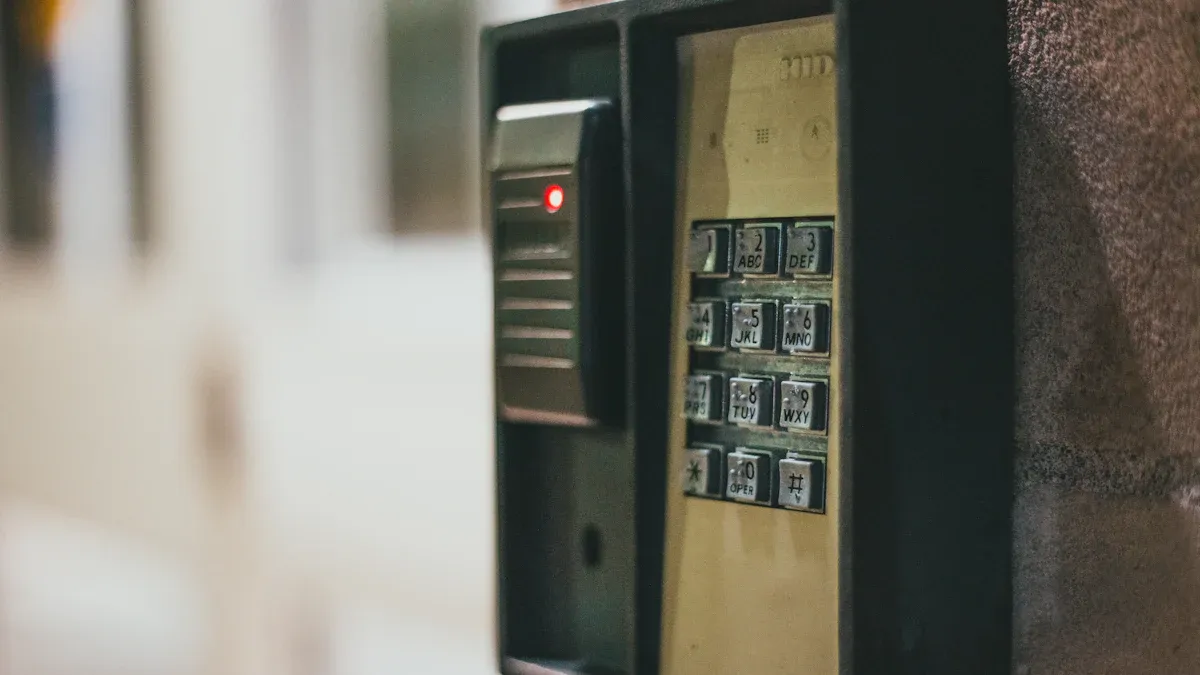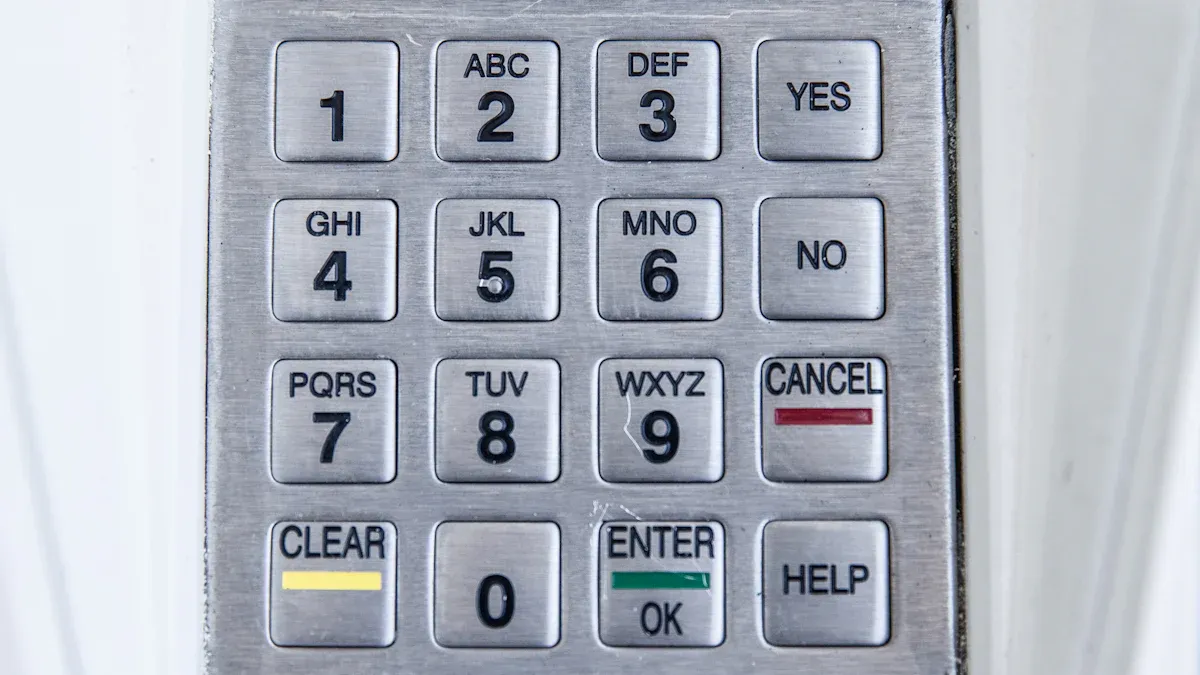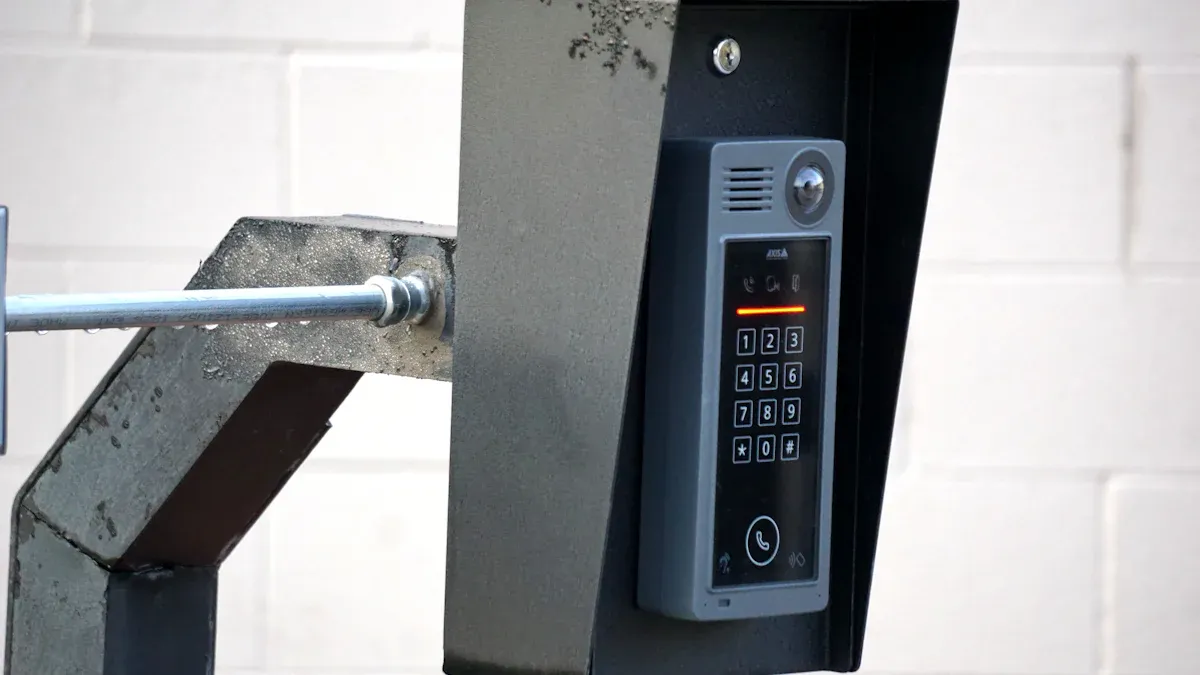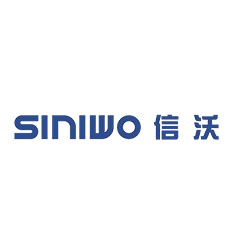
When it comes to securing industrial spaces, you need solutions that can handle tough environments and high demands. That’s where an access control industrial keypad comes in. These keypads offer more than just security—they streamline operations, making it easier to manage who enters restricted areas. Unlike residential or office keypads, they’re built to withstand harsh conditions like extreme weather or heavy use. Some even include features like an industrial braille keypad to ensure accessibility for all users. Staying updated on the latest models in 2025 means you’ll get the best in durability, efficiency, and cutting-edge security.
Key Takeaways
- Industrial keypads improve safety and make work easier in tough places. They manage access to secure areas, letting only approved people enter.
- When picking a keypad, focus on strength and weatherproofing. Find ones with high IP ratings to handle dust, water, and heat or cold.
- Check if the keypad works with your current security system. Pick keypads that follow common standards, so you can upgrade later without big changes.
What Are Industrial Access Keypads and Why Are They Important?
Definition and primary purpose of industrial access keypads
Industrial access keypads are specialized devices designed to control entry to restricted areas in factories, warehouses, and other industrial settings. Unlike regular keypads, these are built to handle tough environments and heavy usage. Their main purpose is to provide secure and efficient access control, ensuring only authorized personnel can enter specific zones. You’ll often find them integrated with larger security systems to streamline operations and reduce risks.
Tip: Think of an industrial access keypad as the gatekeeper of your facility. It doesn’t just protect your space—it also helps you manage who gets in and when.
Key differences between industrial and other types of keypads
Industrial keypads stand out because of their durability and advanced features. While residential or commercial keypads focus on convenience, industrial models prioritize ruggedness. They’re often weatherproof, resistant to tampering, and capable of handling extreme temperatures. Some even offer features like anti-vandal designs or compatibility with heavy-duty gloves.
Here’s a quick comparison:
| Feature | Industrial Keypads | Residential/Commercial Keypads |
|---|---|---|
| Durability | High | Moderate |
| Weather Resistance | Yes | Limited |
| Security Features | Advanced | Basic |
| Accessibility Options | Industrial Braille Keypad | Standard Keypad |
Common use cases in industrial environments
You’ll see industrial access keypads in places where security and efficiency are critical. Factories use them to restrict access to production areas. Warehouses rely on them to secure inventory zones. Even construction sites benefit from these keypads to control entry to hazardous areas. They’re also popular in energy plants and transportation hubs, where safety and compliance are top priorities.
Note: If your facility deals with sensitive materials or high-value assets, an access control industrial keypad is a must-have tool for maintaining security.
Key Features to Look for in Access Control Industrial Keypads

Durability and weather resistance
When choosing an access control industrial keypad, durability should be at the top of your list. Industrial environments can be harsh, with exposure to dust, moisture, and extreme temperatures. A keypad designed for these conditions will last longer and perform reliably. Look for models with weatherproof ratings like IP65 or higher. These ratings indicate resistance to water and dust, ensuring the keypad works even in tough outdoor settings.
Tip: If your facility operates in extreme climates, consider keypads made from corrosion-resistant materials like stainless steel.
Security features (e.g., encryption, anti-tampering mechanisms)
Security is non-negotiable. Modern keypads come with advanced features like encrypted communication to prevent hacking. Anti-tampering mechanisms, such as alarms triggered by unauthorized access attempts, add an extra layer of protection. These features ensure that your access control industrial keypad doesn’t just manage entry but actively safeguards your facility.
Compatibility with other access control systems
Your keypad should integrate seamlessly with existing systems like card readers, biometric scanners, or surveillance cameras. Compatibility ensures you can build a comprehensive security network without replacing your current setup. Always check if the keypad supports standard protocols like Wiegand or OSDP for smooth integration.
Ease of installation and maintenance
Nobody wants a keypad that’s a headache to install or maintain. Opt for models with straightforward installation processes, like plug-and-play designs. Maintenance should also be simple, with features like modular components that are easy to replace. This saves you time and reduces downtime.
User capacity and customization options
Think about how many users will need access. Some keypads support hundreds of unique codes, while others can handle thousands. Customization options, like setting different access levels for employees, make it easier to manage who can enter specific areas. This flexibility is especially useful in large facilities with multiple zones.
Note: A keypad with high user capacity and customization options grows with your business, making it a smart long-term investment.
Top Access Control Industrial Keypads in 2025: A Comparison

Overview of the top models and their manufacturers
When it comes to choosing the best access control industrial keypad in 2025, you’ve got plenty of options. Leading manufacturers like ButterflyMX, Brivo, ZKTeco, Honeywell, and Kisi have all stepped up their game this year. Each brand offers unique features tailored to different industrial needs.
- ButterflyMX: Known for its sleek designs and user-friendly interfaces, ButterflyMX keypads are perfect for facilities that prioritize both functionality and aesthetics.
- Brivo: Brivo focuses on cloud-based solutions, making it easy for you to manage access remotely. Their keypads are ideal for tech-savvy users.
- ZKTeco: If you’re looking for advanced biometric integration, ZKTeco is a top contender. Their keypads often combine fingerprint scanning with traditional PIN entry.
- Honeywell: A trusted name in security, Honeywell keypads are built for durability and reliability. They’re a great choice for harsh industrial environments.
- Kisi: Kisi specializes in smart access systems that integrate seamlessly with mobile apps. Their keypads are perfect for modern, connected facilities.
Each of these manufacturers brings something unique to the table, so your choice will depend on your specific needs and priorities.
Key differences in features, pricing, and performance
Not all keypads are created equal. Some excel in durability, while others shine in advanced features or affordability. Here’s a breakdown of what sets these models apart:
-
Features:
- ButterflyMX and Kisi focus on user-friendly interfaces and smart integrations.
- ZKTeco stands out with its biometric capabilities, offering an extra layer of security.
- Honeywell prioritizes ruggedness, making their keypads ideal for extreme conditions.
- Brivo leads in cloud-based management, perfect for remote access control.
-
Pricing:
- Kisi and Brivo tend to be on the higher end due to their advanced tech.
- Honeywell and ZKTeco offer mid-range options that balance cost and features.
- ButterflyMX provides budget-friendly models without compromising on quality.
-
Performance:
- Honeywell keypads are built to last, even in the toughest environments.
- Kisi and Brivo excel in connectivity and remote management.
- ZKTeco delivers top-notch security with its biometric features.
- ButterflyMX offers reliable performance with a focus on ease of use.
Tip: Think about what matters most to you—whether it’s durability, advanced features, or cost-effectiveness—before making a decision.
Comparison table summarizing the top models
To make things easier, here’s a quick comparison of the top access control industrial keypads in 2025:
| Brand | Key Features | Best For | Price Range |
|---|---|---|---|
| ButterflyMX | Sleek design, user-friendly | Budget-friendly facilities | $200 – $400 |
| Brivo | Cloud-based management | Remote access control | $400 – $600 |
| ZKTeco | Biometric integration | High-security environments | $300 – $500 |
| Honeywell | Rugged and durable | Harsh industrial settings | $250 – $450 |
| Kisi | Smart integrations, mobile-friendly | Modern, connected facilities | $500 – $700 |
This table gives you a snapshot of what each brand offers, helping you narrow down your options based on your needs and budget.
Mini Reviews of the Best Access Control Industrial Keypads in 2025
ButterflyMX Keypad: Features, Pros, and Cons
ButterflyMX keypads combine sleek design with user-friendly functionality. You’ll love how easy it is to set up and manage access codes. These keypads integrate seamlessly with mobile apps, letting you control access remotely. They’re perfect for facilities that want a modern look without sacrificing performance.
Pros:
- Simple installation process.
- Mobile app integration for remote access.
- Affordable pricing for budget-conscious buyers.
Cons:
- Limited durability in extreme weather.
- Not ideal for high-security environments.
Tip: If aesthetics and ease of use matter to you, ButterflyMX is a great choice.
Brivo Keypad: Features, Pros, and Cons
Brivo keypads focus on cloud-based access control. You can manage entry permissions from anywhere, making them ideal for tech-savvy users. These keypads also offer robust security features, including encrypted communication.
Pros:
- Cloud-based management for flexibility.
- Strong encryption for enhanced security.
- Great for remote facilities.
Cons:
- Higher price point.
- Requires reliable internet connectivity.
Note: Brivo keypads are perfect for facilities that prioritize remote access and advanced security.
ZKTeco Keypad: Features, Pros, and Cons
ZKTeco keypads stand out with their biometric integration. You can use fingerprint scanning alongside PIN codes for added security. These keypads are built for environments where high-security measures are essential.
Pros:
- Biometric features for extra protection.
- Durable design for industrial use.
- Affordable mid-range pricing.
Cons:
- Biometric sensors may require regular cleaning.
- Limited compatibility with older systems.
Alert: Choose ZKTeco if you need top-notch security without breaking the bank.
Honeywell Keypad: Features, Pros, and Cons
Honeywell keypads are built to last. They’re rugged and reliable, making them ideal for harsh industrial settings. You’ll appreciate their straightforward design and dependable performance.
Pros:
- Exceptional durability for tough environments.
- Easy to install and maintain.
- Trusted brand with a solid reputation.
Cons:
- Limited advanced features.
- Bulkier design compared to competitors.
Tip: Honeywell keypads are a safe bet for facilities exposed to extreme conditions.
Kisi Keypad: Features, Pros, and Cons
Kisi keypads offer smart integrations with mobile apps and cloud systems. You can customize access permissions easily, making them perfect for modern, connected facilities.
Pros:
- Advanced smart features.
- High user capacity for large teams.
- Sleek design with mobile-friendly options.
Cons:
- Expensive compared to other models.
- Requires tech-savvy users for setup.
Note: Kisi keypads are ideal for facilities that value connectivity and cutting-edge technology.
How to Choose the Best Access Control Industrial Keypad for Your Needs
Choosing the right industrial access keypad can feel overwhelming with so many options available. But don’t worry—breaking it down into key factors makes the process much simpler. Let’s explore what you should consider to find the perfect fit for your facility.
Assessing your security requirements
Start by asking yourself: What level of security does your facility need? If you’re protecting high-value assets or sensitive areas, you’ll want a keypad with advanced features like biometric authentication or encrypted communication. On the other hand, if you’re managing access to less critical zones, a simpler model with PIN entry might do the job.
Think about the number of users as well. Do you need to manage access for a handful of employees or hundreds of workers? Keypads with high user capacity and customizable access levels can help you stay organized and secure.
Tip: For facilities with multiple zones, consider a keypad that allows you to assign different access permissions to different groups. This way, you can control who gets into which areas.
Considering environmental factors (e.g., weather, location)
Industrial environments can be tough, and your keypad needs to handle whatever comes its way. If your keypad will be installed outdoors, look for weatherproof models with high IP ratings (like IP65 or higher). These ratings ensure the device can resist dust, rain, and even extreme temperatures.
For facilities in corrosive environments, such as chemical plants or coastal areas, materials like stainless steel or aluminum are a must. And don’t forget about physical durability—keypads in high-traffic areas should be resistant to wear and tear.
Alert: If your workers wear gloves, make sure the keypad is glove-friendly. Some models even come with oversized buttons for easier use in such conditions.
Budget considerations and ROI
Your budget matters, but don’t just focus on the upfront cost. Think about the long-term return on investment (ROI). A cheaper keypad might save you money now, but if it breaks down frequently or lacks essential features, it could cost you more in the long run.
Investing in a high-quality keypad with advanced security features and durability can save you money on repairs, replacements, and potential security breaches. Plus, some models offer energy-efficient designs, which can reduce operational costs over time.
Note: Balance your budget with your needs. Spending a little more upfront for a reliable keypad often pays off in the long term.
Evaluating compatibility with existing systems
Before you buy, check if the keypad will work with your current access control system. Does it support standard protocols like Wiegand or OSDP? Can it integrate with other devices, such as card readers, biometric scanners, or surveillance cameras?
Compatibility ensures you won’t need to overhaul your entire security setup. It also makes future upgrades easier. If you’re planning to expand your system later, choose a keypad that can grow with your needs.
Tip: If you’re unsure about compatibility, consult with the manufacturer or a security expert. They can help you avoid costly mistakes.
Importance of customer support and warranty
Even the best keypads can run into issues, so reliable customer support is crucial. Look for manufacturers that offer responsive support teams and clear troubleshooting guides. A good warranty is also a must—it protects your investment and gives you peace of mind.
Some brands even provide extended warranties or service plans. These can be especially valuable for keypads in demanding environments where wear and tear are more likely.
Reminder: Don’t overlook customer reviews. They can give you real-world insights into the quality of support and warranty coverage a brand offers.
By considering these factors, you’ll be well-equipped to choose an industrial access keypad that meets your needs and keeps your facility secure. Remember, the right keypad isn’t just a purchase—it’s an investment in safety and efficiency.
Industrial access keypads are essential for keeping your facility secure and efficient in 2025. Focus on durability, security, and compatibility when choosing one.
Tip: Think about your needs first. Whether it’s weather resistance or advanced features, pick a keypad that fits your environment and budget.
FAQ
1. How do I know if an industrial keypad is weatherproof?
Look for an IP rating (e.g., IP65). This tells you the keypad’s resistance to dust and water. Higher numbers mean better protection.
Tip: For outdoor use, choose IP65 or higher-rated keypads.
2. Can I install an industrial keypad myself?
Yes, many models offer plug-and-play designs for easy installation. However, for complex systems, hiring a professional ensures proper setup and integration.
Note: Always check the installation guide before starting.
3. What’s the lifespan of an industrial access keypad?
Most keypads last 5–10 years, depending on usage and environment. Durable materials and regular maintenance can extend their lifespan.
Alert: Harsh conditions may reduce longevity. Choose rugged models for tough environments.


